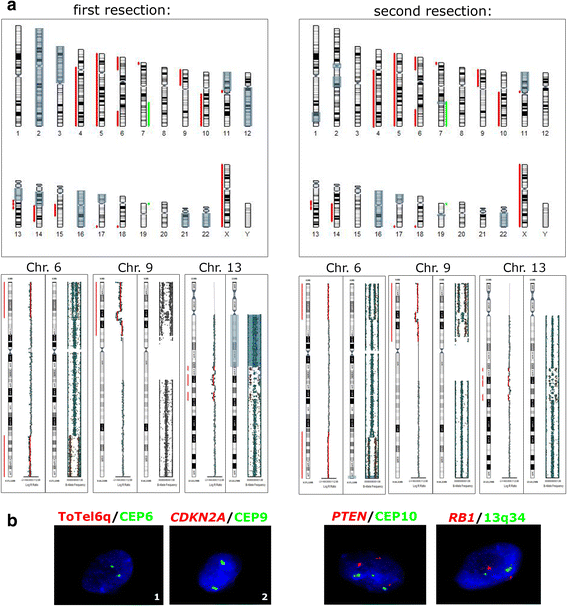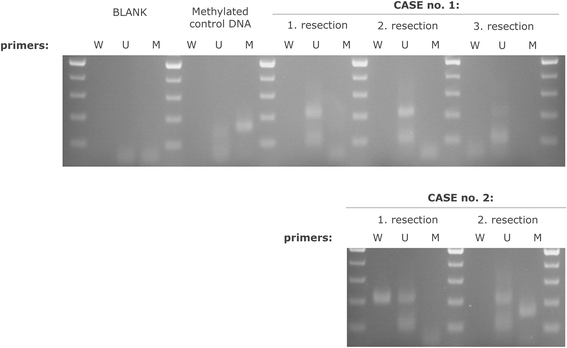Primary and recurrent diffuse astrocytomas: genomic profile comparison reveals acquisition of biologically relevant aberrations
- PMID: 26865861
- PMCID: PMC4748601
- DOI: 10.1186/s13039-016-0222-3
Primary and recurrent diffuse astrocytomas: genomic profile comparison reveals acquisition of biologically relevant aberrations
Abstract
Background: Diffuse astrocytomas are characterized by their highly variable biological behavior. The possibility that tumors develop novel aberrations, with relevant biological properties, is often neglected. In this study, we present two cases of diffuse astrocytoma in which additional cytogenetic and epigenetic markers with potential influence on cell proliferation or differentiation were detected at relapse.
Findings: The biopsies taken from the primary and recurrent tumors of two patients were analyzed with molecular methods to detect copy number variations (CNVs), gene mutations and epigenetic changes. Both cases were characterized by the R132H mutation in the isocitrate dehydrogenase 1 (IDH1) gene. Features typical of astrocytomas, such as copy-neutral loss of heterozygosity at 17p and the deletion of the cyclin-dependent kinase inhibitor 2A (CDKN2A) gene, were also detected in both cases. These markers were present in the primary and recurrent lesions. Other aberrations, predominantly deletions or amplifications of chromosomal segments and the hypermethylation of gene promoters, were detected in the recurrent lesions.
Conclusions: The IDH1 mutation was the primary event, as previously reported. According to our observations, the methylation of promoters constituted later events, which may have further disrupted cell proliferation and/or differentiation, together with additional CNVs.
Keywords: Clonality; Diffuse astrocytoma; Isocitrate dehydrogenase 1; MutL homolog 3.
Figures





References
-
- Wick W, Hartmann C, Engel C, Stoffels M, Felsberg J, Stockhammer F, et al. NOA-04 randomized phase III trial of sequential radiochemotherapy of anaplastic glioma with procarbazine, lomustine, and vincristine or temozolomide. J Clin Oncol. 2009;27:5874–80. doi: 10.1200/JCO.2009.23.6497. - DOI - PubMed
-
- Hartmann C, Meyer J, Balss J, Capper D, Mueller W, Christians A, et al. Type and frequency of IDH1 and IDH2 mutations are related to astrocytic and oligodendroglial differentiation and age: a study of 1,010 diffuse gliomas. Acta Neuropathol. 2009;118:469–74. doi: 10.1007/s00401-009-0561-9. - DOI - PubMed
-
- Dong X, Liu RY, Chen WD. Correlation of promoter methylation in the MGMT gene with glioma risk and prognosis: a meta-analysis. Mol Neurobiol. 2014
-
- Lass U, Numann A, von Eckardstein K, Kiwit J, Stockhammer F, Horaczek JA, et al. Clonal analysis in recurrent astrocytic, oligoastrocytic and oligodendroglial tumors implicates IDH1- mutation as common tumor initiating event. Plos One. 2012;7:14. doi: 10.1371/journal.pone.0041298. - DOI - PMC - PubMed
LinkOut - more resources
Full Text Sources
Other Literature Sources
Miscellaneous

